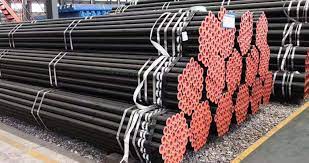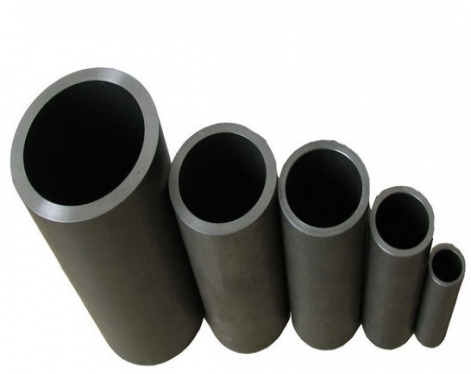What is mild steel?
Mild steel is carbon steel with a carbon content of less than 0.25%. It is also called mild steel because of its low strength, low hardness and softness. It includes most ordinary carbon structural steel and some high-quality carbon structural steel. Most of them are used for engineering structural parts without heat treatment, and some are used for mechanical parts requiring wear resistance after carburizing and other heat treatments.
The annealed structure of low carbon steel is ferrite and a small amount of pearlite, which has lower strength and hardness and better plasticity and toughness. Therefore, it has good cold formability and can be cold formed by curling, bending, stamping and other methods. This steel has good weldability. Low carbon steel with very low carbon content has very low hardness and poor machinability. Normalizing treatment can improve its machinability.

The characteristics of black mild steel pipe
Black mild steel pipe has a greater aging tendency, including both quenching aging tendency and deformation aging tendency. When steel cools rapidly from high temperatures, the carbon and nitrogen in the ferrite are in a supersaturated state, which can slowly form iron carbonitrides at room temperature. Therefore, the strength and hardness of the steel increase, while the plasticity and toughness decrease. This This phenomenon is called quenching aging.
Black mild steel pipe will age even if it is air-cooled without quenching. Low carbon steel generates a large number of dislocations through deformation. The carbon and nitrogen atoms in the ferrite interact elastically with the dislocations, and the carbon and nitrogen atoms gather around the dislocation lines. This combination of carbon, nitrogen atoms and dislocation lines is called a Korotkoff air mass. It will increase the strength and hardness of steel but reduce its plasticity and toughness. This phenomenon is called deformation aging. Deformation aging is more harmful to the plasticity and toughness of low carbon steel than quenching aging. There are two obvious upper and lower yield points on the tensile curve of low carbon steel.
From the appearance of the upper yield point to the end of the yield extension, a surface wrinkle zone formed due to uneven deformation appears on the surface of the specimen, which is called the Lüders zone. Many stamped parts are often scrapped because of this. There are two ways to prevent it. A high pre-deformation method. The pre-deformed steel will also produce Lüders bands when stamped after being placed for a period of time. Therefore, the pre-deformed steel should not be placed for too long before stamping. The other is to add aluminum or titanium to the steel to form a stable compound with nitrogen to prevent deformation and aging caused by the formation of Coriolis gas clusters.
Mild steel is a tough material. The stress-strain curve during tension is mainly divided into four stages: elastic stage, yield stage, strengthening stage, and local deformation stage. There are obvious yielding and necking phenomena in the local deformation stage. There is an elastic stage at the beginning, and it rises along a straight line in full compliance with Hooke's law. After the proportional limit, the deformation accelerates, but there is no obvious yield stage.
Mild steel is carbon steel with a carbon content of less than 0.25%. It is also called mild steel because of its low strength, low hardness and softness. It includes most ordinary carbon structural steel and some high-quality carbon structural steel. Most of them are used for engineering structural parts without heat treatment, and some are used for mechanical parts requiring wear resistance after carburizing and other heat treatments.
The annealed structure of low carbon steel is ferrite and a small amount of pearlite, which has lower strength and hardness and better plasticity and toughness. Therefore, it has good cold formability and can be cold formed by curling, bending, stamping and other methods. This steel has good weldability. Low carbon steel with very low carbon content has very low hardness and poor machinability. Normalizing treatment can improve its machinability.

The characteristics of black mild steel pipe
Black mild steel pipe has a greater aging tendency, including both quenching aging tendency and deformation aging tendency. When steel cools rapidly from high temperatures, the carbon and nitrogen in the ferrite are in a supersaturated state, which can slowly form iron carbonitrides at room temperature. Therefore, the strength and hardness of the steel increase, while the plasticity and toughness decrease. This This phenomenon is called quenching aging.
Black mild steel pipe will age even if it is air-cooled without quenching. Low carbon steel generates a large number of dislocations through deformation. The carbon and nitrogen atoms in the ferrite interact elastically with the dislocations, and the carbon and nitrogen atoms gather around the dislocation lines. This combination of carbon, nitrogen atoms and dislocation lines is called a Korotkoff air mass. It will increase the strength and hardness of steel but reduce its plasticity and toughness. This phenomenon is called deformation aging. Deformation aging is more harmful to the plasticity and toughness of low carbon steel than quenching aging. There are two obvious upper and lower yield points on the tensile curve of low carbon steel.
From the appearance of the upper yield point to the end of the yield extension, a surface wrinkle zone formed due to uneven deformation appears on the surface of the specimen, which is called the Lüders zone. Many stamped parts are often scrapped because of this. There are two ways to prevent it. A high pre-deformation method. The pre-deformed steel will also produce Lüders bands when stamped after being placed for a period of time. Therefore, the pre-deformed steel should not be placed for too long before stamping. The other is to add aluminum or titanium to the steel to form a stable compound with nitrogen to prevent deformation and aging caused by the formation of Coriolis gas clusters.
Mild steel is a tough material. The stress-strain curve during tension is mainly divided into four stages: elastic stage, yield stage, strengthening stage, and local deformation stage. There are obvious yielding and necking phenomena in the local deformation stage. There is an elastic stage at the beginning, and it rises along a straight line in full compliance with Hooke's law. After the proportional limit, the deformation accelerates, but there is no obvious yield stage.
Previous:Types of welded steel pipes









